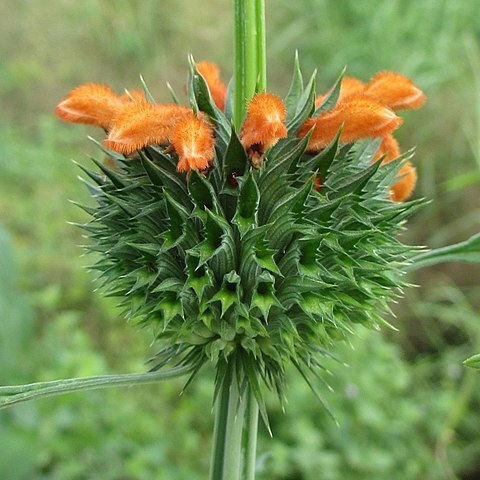Shrub 1-5 m tall, branching from a thick woody base; internodes 20-80 mm long, in the inflorescence 45-325 mm long, sometimes with a few leafy nodes in between the verticils; nodes prominent; leaf scars prominent, sometimes with a marginal rim. Leaves petiolate; blade 9-170 x 4-85 mm, broadly ovate to ovate or obovate, apex acute to rounded, base cordate, truncate or angustate, margin crenate, upper surface green, loosely pubescent to velvety, rarely almost smooth, lower surface silvery velvety to pubescent or rarely almost smooth, except on nerves; when indumentum is sparse, the surface is covered by sessile, colourless glands; petiole 4-110 mm long. Inflorescence of 2 to 5 spherical to subspherical (horizontally flattened below) verticils; verticils (excluding corollas) 28-78 mm in diameter with 10-18 verticil branches 5-20 mm long, dichasially branched at base; pedicels 0.5-7 mm long; bracts leaf-like, sometimes early deciduous, 8-85 x 2-25 mm; petiole 1-25 mm long; bracteoles 6-22 x 0.3-2.5 mm, linear, green with acuminate white apex. Calyx 14-30 mm long, 4-5.5 mm in diameter, usually curved forwards, slightly enlarging in fruit, bilabiate or without produced lips, 8(-11)-toothed or sometimes all teeth obsolete, shortly pubescent to velutinous; calyx teeth rigid, deltoid, with apiculate white apex, the dorsal one 2-14 mm long, the 3 or 5 lower teeth bend downwards, more or less united to a lower lip. Corolla 24-45 mm long, covered by orange-rufous hairs (albinistic forms are rare in southern Africa); tube 10-25 mm long, with one distinct ring of hairs inside, lower lip 6-10 mm long, the median lobe retuse, 2.5-4.5 mm long. Fresh pollen orange-coloured. Nutlets 2.4-4.3 x 1.2-2.1 mm, blackish brown, glossy.
More
Perennial shrub, 1-5 m high; base woody, much-branched, nodes and leaf scars prominent. Leaves petiolate, ovate, broadly ovate or obovate, 9-170 x 4-85 mm, base cordate to angustate, apex acute, margins crenate; upper surface green, pubescent to velvety, lower surface silvery velvety; colourless, sessile glands present. Inflorescence simple; verticillasters 2-5, subsperical, 28-78 mm in diam. Flowers covered by orange-rufous hairs. Calyx 14-30 mm long; bilabiate (or not), teeth 8(-11), rigid, deltoid, apex apiculate and white, dorsal one 2-14 mm long, 3 or 5 lower teeth bent downwards. Corolla: tube 10-15 mm long, 1 ring of hairs inside; median lobe of lower lip retuse, 2.5-4.5 mm long. Flowering time all year.
An erect shrub. It grows 5 m high. It has a thick woody base. The leaf blade is 1-17 cm long by 1-9 cm wide. It is broadly oval. The leaves are green on the upper surface and silvery underneath. The flowers are usually orange. The upper lobe is 12-30 mm long. The seeds are 2-4 mm long by 1-2 mm wide. They are dark brown and glossy. There are at least 2 varieties.
Like L. leonurus but leaves ovate, calyx bilabiate with larger upper tooth and corolla 24-45 mm long with lower lobes spreading.
It is a tropical plant. It can grow in hot arid places with a dry season of 6-11 months. It grows between 50-3,700 m above sea level in warmer places and lower in cooled places. It grows in areas with a rainfall between 500-2,000 mm per year. It can grow in arid places.
More
Rocky outcrops and in well-drained soils on hillsides at elevations from 1,000-2,000 metres, but descending to sea level in the south of its range.

